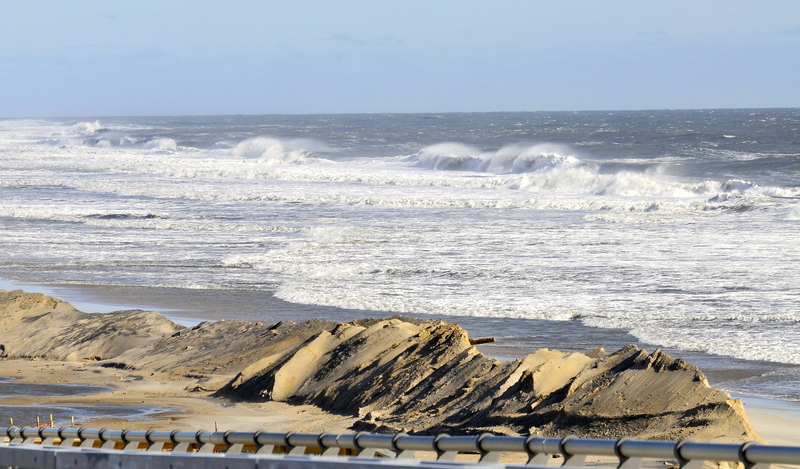After two storms within four months twice closed the Indian River Inlet bridge, state and federal officials say they now have a plan to protect Route 1 and the bridge.
The area north of the inlet has become a pinch-point; even with sand being pumped from the southside beach, the north side beach has become narrow and susceptible to beach erosion. The storms caused wide breaches in the dunes that allowed sand and water onto Route 1, closing the road and the bridge.
It appears three agencies involved in protecting the bridge now agree a restored beach offers the best protection for Route 1 leading to the bridge: the U.S. Army Corps of Engineers is responsible for the Indian River Inlet; the Delaware Department of Natural Resources and Environmental Control for the beach; and Delaware Department of Transportation for the road and bridge.
It was announced this week that the Army Corps will dredge and pump sand from the inlet to the north side of the inlet where DNREC crews will rebuild the beach, said Tony Pratt, section manager of DNREC's shoreline and waterways management section.
Pratt said the work could begin as early as June or July. Once the project is complete, the beach will have the same profile and dune structure as nearby Reboboth Beach and Bethany Beach, Pratt said.
The dredging will also remove built-up material from the inlet to restore the channel. Money for the project will come from federal Hurricane Sandy relief funds.
Transportation officials have installed a steel wall under the sand along Route 1 near the bridge to protect the integrity of the road foundation. Even as the project was announced, DelDOT officials said there was need for beach replenishment to protect the road.
“DelDOT welcomes any assistance it can receive that will stabilize the shoreline and protect Route 1 from flooding. The road is a key asset in the north-south transportation network along the Delmarva peninsula and a vital link for our beach communities,” said DelDOT Secretary Shailen Bhatt.
Leaking jetty needs repairs
Work is also needed to repair the jetty on the north side of the inlet. Officials discovered a “leak” in the inlet's north-side jetty that could allow sand to flow off the beach into the inlet contributing to beach erosion.
A section of collapsed sidewalk on the northern jetty provided evidence that something is occurring – out of sight, under the jetty. “It's a void where the rocks are collapsing and sand is going through a leak,” Pratt said.
Pratt said officials had been scratching their heads trying to figure out why the beach seemed to narrow even though large amounts of sand were being pumped onto the beach via the sand bypass system.
The pumping operation moves more than 100,000 cubic yards of sand annually across the Indian River Inlet bridge from the south beach to rebuild the beach and dunes on the north-side beach near the inlet. Dan Brower, program manager of DNREC's waterways and shoreline management section, said the natural flow of sand along Delaware's Atlantic coast is from south to north. Jetties constructed in the 1930s to stabilize Indian River Inlet interrupt the natural flow, trapping sand on the south side of the inlet.
Pratt said 40,000 cubic yards of sand had been pumped to the north-side beach since Hurricane Sandy. Without the stepped-up pumping, Pratt said, the breach caused by the March 6 storm would have been much worse. He said the breach was confined to a 200 to 300 foot section of beach compared to a breach about 3,500 feet long during Sandy.
State transportation officials closed flooded Route 1 for more than 24 hours, which also forced closure of the Indian River Inlet bridge.
Long-term plan will be place
Pratt said the corps had plans to re-nourish this section of beach as far back as the early 1990s, but the work was never done. “The beach has never been rebuilt, so it's inadequate to begin with, but we had been able to keep up with the bypass system,” Pratt said.
That was until Oct. 28, 2012, when Hurricane Sandy churned off the coast creating huge waves and storm surge that pummeled the coast. It took workers almost a week to remove sand washed over Route 1 near the bridge.
Pratt said recent events have changed the corps' outlook on the area around Indian River Inlet. “The Corps now has a more enlightened approach. They see it more clearly,” Pratt said.
The plan also includes beach nourishment on a schedule of every 10 to 12 years. He said with the amount of projected sea-level rise causing more long-term erosion, that part of the plan, with continual sand pumping via the bypass system, is critical to maintaining the beach.
Officials agree a wide and stable beach provides the best protection to the roadway and $150 million Indian River Inlet bridge.


























































